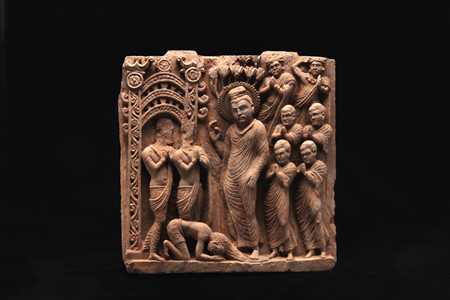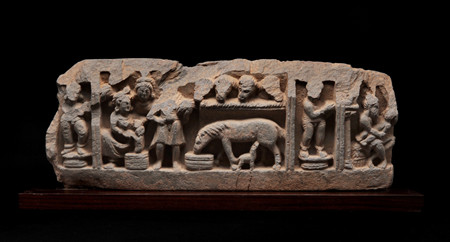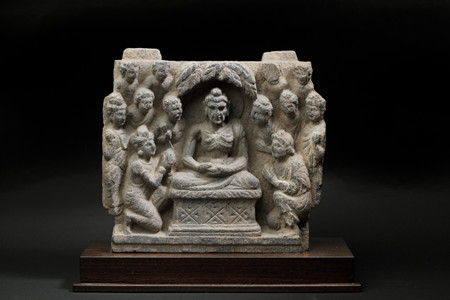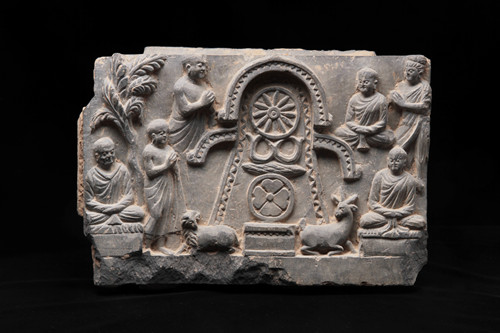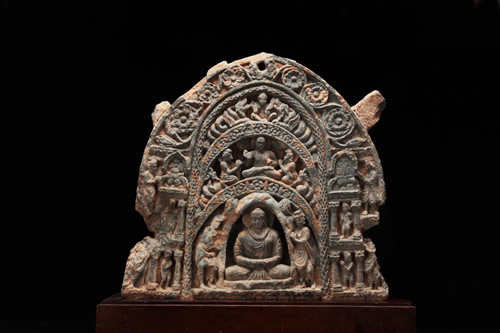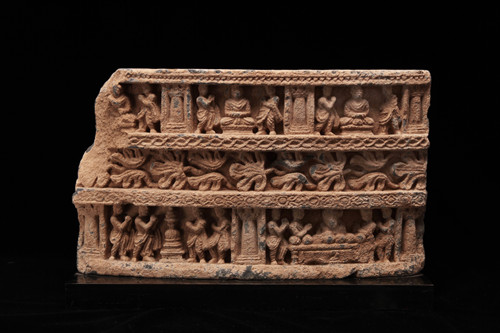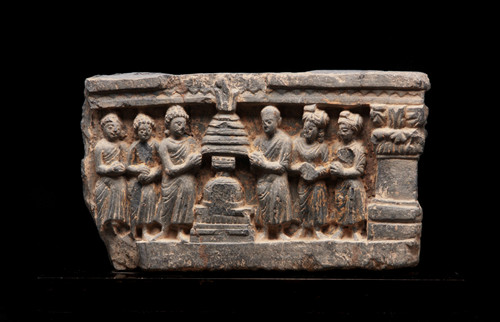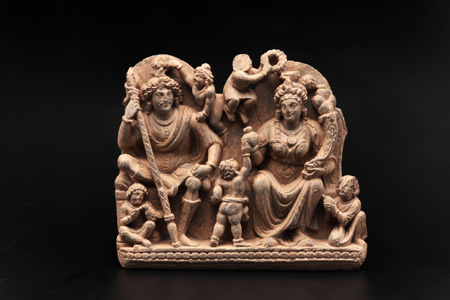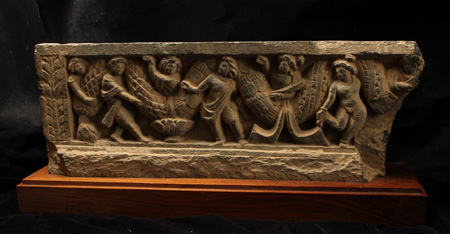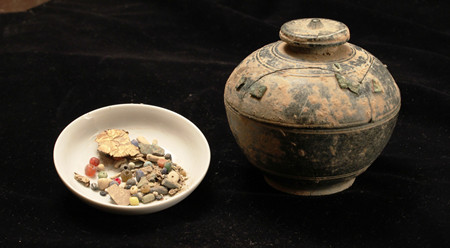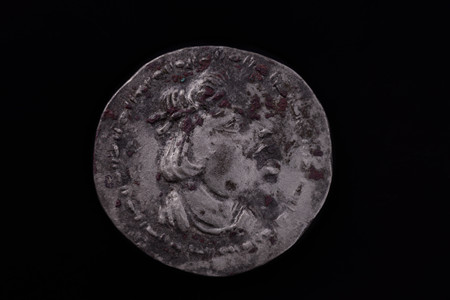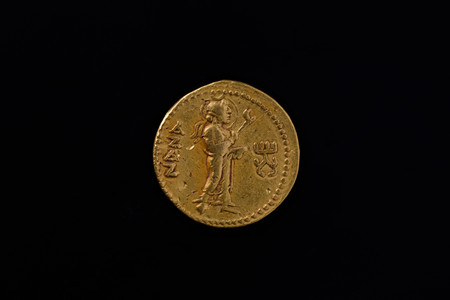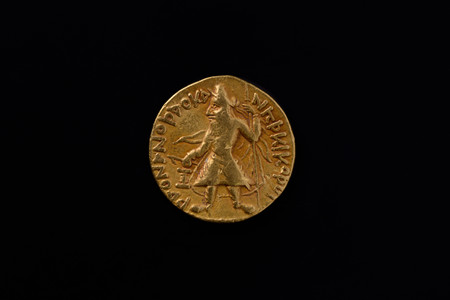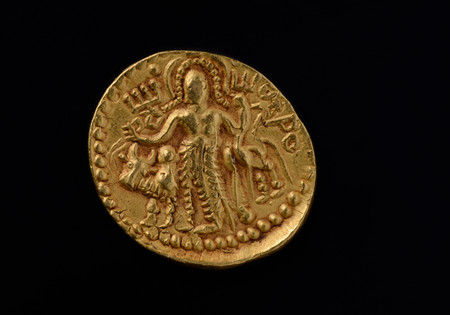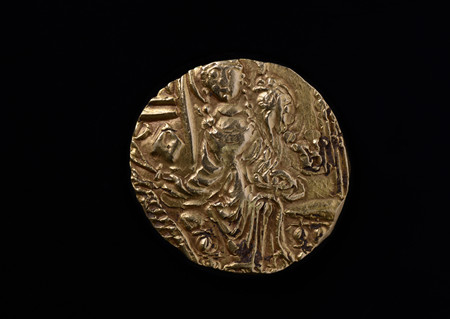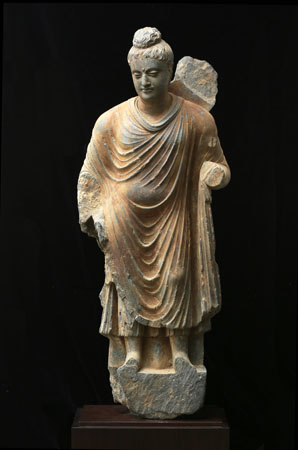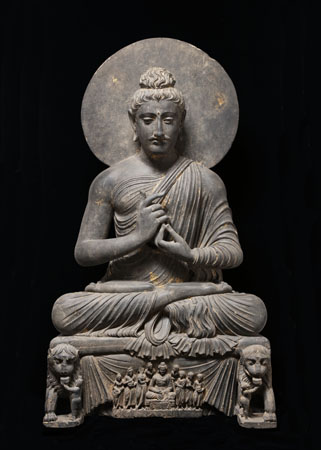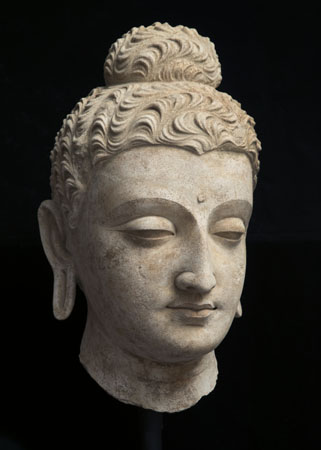Temporary exhibition in Henan Museum -- Gandhara Buddhist Art Exhibition
1/32
Gandhara is the surrounding area of Peshawar basin in northern Pakistan, adjacent to Afghanistan. According to Buddhist scriptures, this place was one of the sixteen great powers in ancient India. Buddhism flourished in Gandhara from the 3rd century BC to the 4th century AD. Gandhara region is located in the main road connecting East Asia, Central Asia and the Indian subcontinent. The Greeks, Cypriots, kusanas and Persians have successively ruled here. The multi cultures of Greece Rome, Persia and India have deeply influenced the local Buddhism, forming the famous Gandhara Buddhist art, and having an important influence on the Buddhist art of East Asia including China.
Unit 1 Buddha and Bodhisattva
Buddha is the meaning of the awakened person. "Bodhisattva" is the abbreviation of Bodhisattva, which refers to the compassionate person who helps all living beings and has heavenly consciousness. The Buddha before enlightenment was also called Bodhisattva. During the period of the kusana Empire, Mahayana Buddhism rose in Gandhara area. The characteristics of Greek civilization were integrated into Buddhism. Kusana believers accepted the concept and artistic expression of Western gods and began to use human images to express Buddha and Bodhisattva. Therefore, Gandhara area is known as the hometown of Buddha.
Buddha seated
This is a Buddha statue with the seal of meditation. According to the size of Buddha, this piece should have a lotus seat about 50 cm high. It is handed down from Landi kotal in the border area between Afghanistan and Pakistan. The face of the Buddha is very beautiful, and the corners of the mouth are slightly tilted, as if with a faint smile. The clothing pattern is elegant and smooth, and the overall posture is peaceful and well preserved. It can be regarded as one of the finest Buddha statues in Gandhara.
This is a plaster Buddha statue. The stucco technique was spread from Rome to Gandhara in the late 2nd and early 3rd century AD, especially in hadda of Afghanistan and Takkasila of Pakistan. The method of making grey statues is to wind ropes on wood and plaster them for modeling. In Gandhara area, scrapers for making plaster statues are often unearthed.
Buddha standing statue
Buddha's hair is flowing wavy, showing the strong influence of ancient Greek and Roman style.. The shape of the left foot slightly forward is also carved from ancient Greece. The statue is also known as the walking Buddha. Although it is not rare to see Buddha statues in this posture, it is not clear what the specific implication is.
The site of the excavation is said to be takht-i-bahi. The soil in this area contains a lot of iron. Therefore, after the iron element is attached to the statue, the appearance of the whole statue appears red. Takot Bayi is the center of Gandhara, where most statues of Gandhara peak period are unearthed.
Buddha seated
This is a typical exquisite Buddha statue in Gandhara's heyday. It has Greek style wavy hair bun and smooth clothing patterns. Buddha's face is peaceful, full of wisdom, making Zen meditation seal, sitting on the lion's seat with Maitreya Bodhisattva carved in the center of the pedestal, and there are many donors around it. The two ends of the pedestal are carved with majestic lions, who are drinking grape wine from fairies.
A little gold foil remained in the whole body. Although the nose and fingers of the Buddha are slightly restored, there are not many such tall and exquisite Gandhara statues. This one can be called the best of Gandhara Buddha statues. There is a similar exquisite statue in Pakistan's Peshawar Museum.
Head Buddha
The head of the Buddha has Greek wavy hair, slightly closed eyes and a kind face. The feature of longer earlobe should be influenced by the style of Indian Buddhist statues.
Bodhisattva and benefactor in relief
This piece is handed down from Kunduz region of Afghanistan, or the Dharma seat for Buddha or Bodhisattva. The front end is decorated with two squatting lions. The Bodhisattva in the middle sits with Zen meditation seal, wears heavenly clothes, and has a head light. He should be a Sakyamuni. On the left and right sides of the Bodhisattva, there are three donors in Indian and kusana costumes, holding offerings. This piece is made of limestone, which is rare in the Buddha statues of Gandra.
Buddha and Bodhisattva relief
The upper part of this piece is the Buddha sitting statue, and the lower part is the statue of Bodhisattva. In the middle, it is supposed to be the Buddha sitting statue. This is probably the latest work of Matura.
Unit 2 Bensheng, karma and Buddhist stories
Gandhara pagoda is often decorated with sculptures depicting the story of Sakyamuni, which is an important theme of early Buddhist art. I told the story of Sakyamuni's Bodhisattva practice in his previous life. Karma describes the story of karma in Buddhism, while Buddhism tells the story of Sakyamuni's life and peace. In Gandhara area, the images of Buddha biography are mainly, but the images of Bensheng and karma stories are not very developed.
After conquering Persia, Assyria, Egypt and Asia Minor and establishing a huge Alexander Empire, Alexander the great, king of Macedonian, went south to India via Afghanistan in 327 B.C., and pointed his troops directly to the hefasis River in Punjab. But because the army was tired of war, Alexander the Great's expedition finally stopped here. In 323 BC, Alexander the great died. Although his empire was divided, a large number of Greeks settled in Central Asia with the army and established many Hellenistic cities, collectively known as "Alexandria". In 250 B.C., diodotus, the general of Bactrian of the Seleucid Kingdom, became independent and established its capital in the city of Lanshi. It is known as Greco Bactrian kingdom in history, which is the "great Xia" in Chinese historical records. Greek art and oriental culture gradually merged, forming a so-called Hellenistic art.
Around 180 B.C., Demetrius I, king of the great Xia Dynasty, invaded Gandhara in northern India at the time of the fall of the Peacock Dynasty. His son, Menander I (155-130 BC), became the first Greek monarch to believe in Buddhism, and his name also appeared in the Buddhist Scripture of Mahatma. Its ruling scope once reached the central Indian Magadha region. It was during this period that Gandhara Buddhist art flourished. Later, during the reign of Kanishka I (127ad-140ad), Buddhism was established as the national religion. With the rise of Mahayana Buddhism, the belief of pure land and Maitreya also flourished.
The relief of Buddha's teaching in burning lamp
The content of this piece is the scene of lighting the lamp and teaching Buddha, and covering the mud with cloth. In this picture, the cloud boy bows down and kneels down to prevent the light burning Buddha from slipping and dropping his long hair to the ground. The light burning Buddha stands in the center, and the lotus flowers are scattered on the top of the head. The door on the left side of the screen is in Indian style. The lamp burning Buddha is one of the ancient Buddhas in the past. When he was born, everything around him was as bright as a lamp, so he was called the light burning Buddha. According to the Buddhist scriptures, Sakyamuni's previous life was a young man named Yun Tongzi. When he met the burning lamp Buddha in Lotus City, he bought a seven stem lotus from a maid in green. When he saw the lantern Buddha, he scattered the flowers in the air to provide for him. Lighting lamp Buddha is a prophecy given by Yun Tongzi, who said he would be a Buddha in the next life, named Sakyamuni Buddha.
Relief sculpture with the image in the tire
This painting depicts the reincarnation of the white elephant. "Buddha's praise" says that Madame moye lies on the bed, and the crown prince reincarnates from the world. The relief shows the queen dreaming of a white elephant in her belly. The white elephant has a backlight and a lamp to the right of Mrs. moye to indicate the night. On the left is the maid. In front of the bed, there was a low stool for feet, which was a common decoration at that time. The stone column in the image is the Corinthian order of ancient Greece.
Relief of the birth of Royal Horse
When Sakyamuni was born, the white horse and the servant Che Ni, who would serve the Buddha in the future, were also born at the same time. This piece shows the scene of car hiding and the birth of white horse. On the right side of the relief is a fairy who embraces the prince Sakyamuni.
Relief of Buddha's fasting asceticism
This is a scene in which the Buddha went to the forest near the nilian Chan River for enlightenment and interrupted his food practice. With the deepening of practice, the Buddha was on the verge of death. At the top left of the Buddha is the Vajra holding a Vajra pestle, surrounded by worshippers. The pedestal under the Buddha is carved with stone, and the leaves on his head indicate that the Buddha is sitting under a tree to practice.
The most famous ascetic statue is currently in the Lahore Central Museum in Pakistan. The statue shows the lofty state of Buddha when he is wandering between life and death, which is very vivid.
On relief sculpture in the early transformation
This painting depicts the scene where the Buddha first spoke to his disciple wubiqiu in Luye garden, symbolizing the Buddha with Dharma theory. The two deer beside the pedestal symbolize the deer park. The top right should be the provider.
Buddha says relief
This relief shows the Buddha sitting in the cave, the emperor sent musicians to play the piano and prayed for the Buddha's words. On the left side of the Buddha is the person who plays the piano, and on the right side is the emperor Shitian.
Eight cent relic relief
After the Buddha's cremation, neighboring countries fell into war because of fighting for Buddhist relics. Finally, the Buddha relic was distributed to eight countries. Tuluna gave the Buddhist relic to the envoys of the eight countries fairly. The lower left part of this relief shows the scene of building pagodas for the Buddhist relics acquired by the country.
Relief sculpture of worship pagoda
In the Mahayana Nirvana Sutra, Anan revealed to the mura that the Buddha's relic should be regarded as the skeleton of the king among the kings, and a pagoda should be built in the place where the relic was cremated. Since the eight cent Buddhist relic, all countries have built the stupa. This is the scene of worshipping the pagoda.
Since the eight cent Buddhist relic, all countries have built the stupa. This is the scene of worshipping the pagoda.
Relief sculpture of worship pagoda
This is a relief sculpture of the pagoda cave, with a pagoda in the center and worshippers around.
Unit 3 images of other gods and beings
There are various gods around Buddha and Bodhisattva, such as Brahma, Emperor Shitian, four heavenly kings and so on. In Gandhara area, because of the influence of Greek Roman culture, there are also mythical images such as Triton and atlas, which are common in building components.
Pangajajaja and the statue of guizimu
She is one of the twenty Dharma protectors. Her husband, pangajajaja, is the God of wealth. In this case, the ghost mother God and the Buddha are sitting on the left and right, with children around the two sides. Pangajuga holds a long gun. The goddess of the devil mother holds the pomegranate in her right hand and cornucopia in her left hand. It is very rare that this piece is well preserved.
Sea god decorative triangle component
This piece is decorated with the ancient Greek god of the sea (ichthyocentaur). The upper body is in the shape of a human, the lower half of the body is a fish, and the foot is a horse's hoof. This triangular building element is located on the side of the foundation of the pagoda.
Rope relief
This image of a boy carrying a flower rope comes from Greek and Roman art. It is used to depict the theme of victory and festival. It is decorated in the middle of the pagoda or on both sides of the ladder. It is very representative in Gandhara art. Some naked children wear garlands and necklaces. The middle of the rope is a supporter who shows his upper body, and is decorated with luxuriant leaves, symbolizing the richness of the Buddha's eternal world.
The image of Yasha
This is a statue in the style of Matura. It is a statue of yecha with a big stomach. It is held high with arms and may hold three treasures.
Unit 4 relic vessels and pagodas
Sarira refers to the relic of Buddha after being cremated, which symbolizes that "the relic of teachings will not be extinguished". The Sutra of nirvana is divided into eight parts by Buddhism. Stupa, transliterated as "mudupa", was originally a kind of tomb building. In the burial ceremony arranged by Buddha himself, there was a stupa built. The pagoda is the sacred belief of Buddhists, the center of the temple, and has an important impact on Buddhist architecture.
Relic container
During the reign of Asoka, he divided the relic into 80000 pieces and gave them to the world for worshippers to build pagodas. In order to preserve Buddhist relics, sacrificial vessels of various materials and shapes appeared. According to the Buddhist scriptures, the relics can be made of gold, silver, glass, crystal, agate and glass. Therefore, there are many precious stones in the vessels.
Relic container
The surface of this piece is covered with gold foil.
Relief sculpture of pagoda Grottoes
This is a relief sculpture with pagoda. Some scholars believe that the pagoda originated from the hut where early monks and Brahmins settled their lives. This dome shaped hut, called dome, has some similarities with the pagoda.
pagoda
This kind of small pagoda is generally divided into five parts: the base (medhi, the bottom round or square foundation surface), the covered bowl, the hemispherical main body, the lithographic platform box (the box on the covered bowl, the square niche for collecting relics, or called the holy skeleton Hall), the column pole (the column pole above the platform), and the cover (the canopy on the pole).
Unit 5 kusana coins
Around 176 B.C., Da Yueshi was forced to move westward to Central Asia by Xiongnu, and made Daxia subject to the rule of yabghus. In the first century, kujula kadphises conquered the other four tribes and established the kusana empire. After that, kujula kadphises continued to go south from Bactria, destroyed the Indian Greek Dynasty and expanded eastward, thus establishing the kusana empire. In the 2nd century, sasanpos invaded, and the kusana gradually split and declined. In the 4th century, the residual forces were destroyed by Hephthalite.
There are many gaps in the history of the Kushan empire. In addition to a small number of Chinese historical materials, the imperial lineage is mainly constructed by unearthed coins. However, there are still great academic disputes about the lineage and the absolute age of the kings. The Kushan coins were deeply influenced by the culture of Hellenistic period, with the images of kings, names and gods on their surface.
Kusana xihou heraos
Heraios is one of the kusana five Xi Hou. This piece is silver 4 drachmas. The head of the king is tied on the front, and the king riding on the back. Behind him was the goddess of Nike, who crowned her with a wreath, and the Greek version of heraos, the tyrant of the kusana. Between the legs of the horse there is the Greek "seck".
Copper coins of the unknown King
There is no royal name in this piece, but there is SOTER Megas, which means "the great savior". It is a common eulogy for the king in Greek coin inscriptions, which aims to promote the glory and greatness of the king. It usually appears on coins with the name of the king to indicate that it was issued by a certain king. However, there is a special coin in the kusana coins, which only has the epithet of "SOTER Megas" but has no royal name. Scholars call its issuer "nameless king".
According to the inscriptions of Laba Kaike, some scholars think that Yan kadphen is the nameless king in the coins. However, some scholars believe that the nameless king should be a vassal of Tianzhu during the reign of Yan kadphen.
This is from Gaby mint. On the obverse is the standing figure of the king in military uniform. The back is decorated with Siva, Shenniu and Kharoshthi inscriptions. On the left are three treasures of Buddhism.
Gold coin of kaniska I
Kanishka I was the fourth king of the kusana empire. He was the most famous King of the kusana Dynasty. He was the protector and promoter of Buddhism. His reign was the heyday of the kusana empire.
On the front is a standing statue of the king holding a scepter and one hand offering sacrifices to the altar, with high crown ribbon, high nose and long beard, flame on the shoulder, robes and trousers, kusana text "king of kings, kusana king Kanishka"; and on the back, Nana, the earth God with light. This God comes from the goddess Anahita in Iranian mythology.
Gold coin of kaniska II
During the period of Kanishka II, the territory of the kusana empire was shrinking, and the west of Amu Darya belonged to the kusana Shah dynasty; to the East, including Kabul, Gandhara and Punjab, it was still ruled by the kusana.
This piece is 1 Dinar gold coin (weighing 7.8 g). On the front, there is an inscription of the king of Mahayana standing on the front of the tripod king. The back is decorated with Shiva and Shenniu.
Gold coin of sendoro
About 360 A.D., the kitara, formerly a vassal of the kusana Empire, replaced the kusana. The name of this dynasty is derived from the founder of the Hun nationality jidora. Its largest territory includes Peshawar, Taxila, Punjab and Jammu. The dynasty was short-lived and was eventually destroyed by the dada people in the fifth century A.D.
It is a 1-denar gold coin (7.8 g) from the Taxila mint. On the front is a standing statue of the king holding a trident sacrificial altar, surrounded by the word "kusana king sent dorosha" in Brahmi. On the back is adoxacio, the God of the earth, sitting on the throne.



